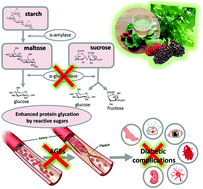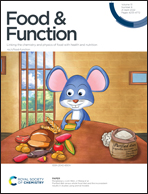In vitro bioactivity evaluation of mulberry leaf extracts as nutraceuticals for the management of diabetes mellitus†
Abstract
There is an increasing need for new options to treat diabetes mellitus at its early stage and natural remedies have been recently reassessed as potential candidates owing to their low-cost and effectiveness. Genus Morus plants contain many active compounds with hypoglycaemic, hypolipidemic, and antioxidant effects. Current research on mulberry chemical composition and bioactivity has been generally carried out only on Asian cultivation, where this plant has been traditionally used in the form of leaf infusion for decades. In this work, twelve Italian mulberry cultivars were fully characterised to fill this gap of knowledge, since a strong correlation among composition, genetics and growing area was proven. Antiglycative and hypoglycaemic effects of leaf extracts were evaluated using different in vitro models. The results indicate that the inhibitory effect on carbohydrate digestive enzymes was likely mediated by 1-deoxynojirimycin, kaempferol, quercetin, and chlorogenic acid, acting in a synergistic way. Besides, the combined antiglycative and carbonyl trapping capacities, tested here for the first time, may help in preventing long-term complications related to AGEs in diabetic patients.

- This article is part of the themed collection: Food & Function HOT Articles 2022


 Please wait while we load your content...
Please wait while we load your content...